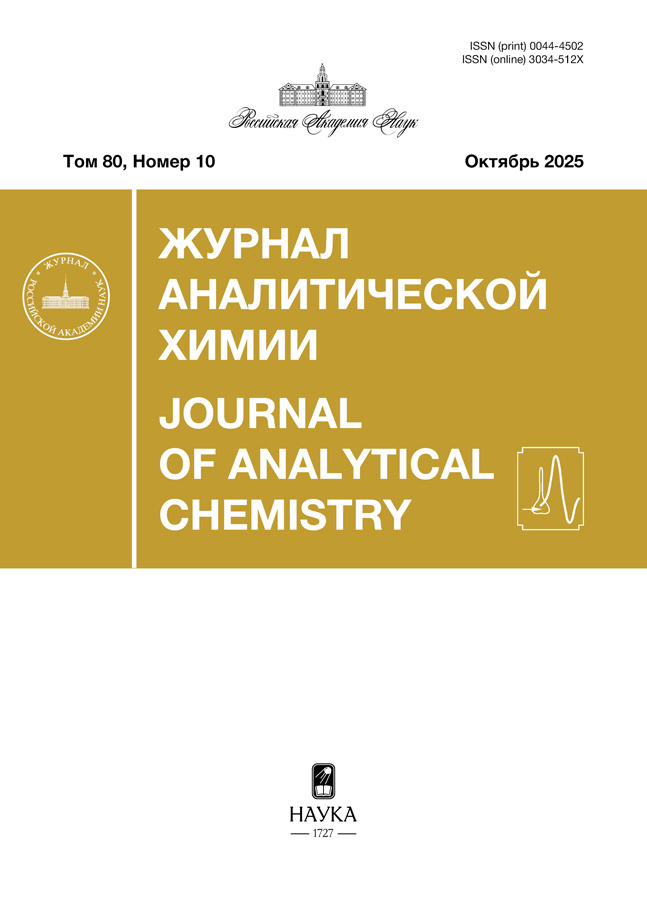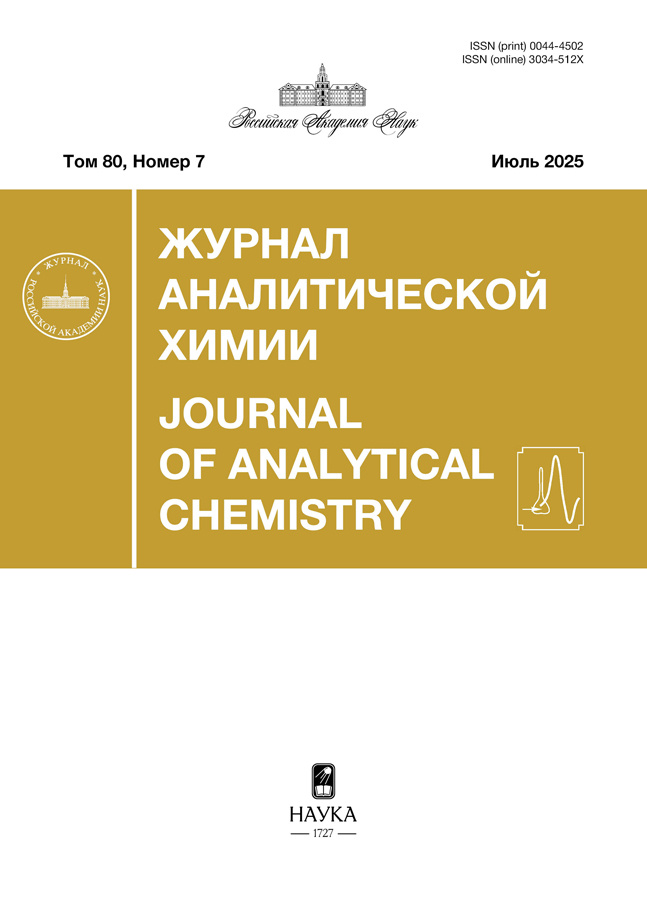Вольтамперометрический сенсор на основе наночастиц диоксида олова для определения таксифолина
- Авторы: Зиятдинова Г.К.1, Тарабукина А.Д.1
-
Учреждения:
- Казанский федеральный университет
- Выпуск: Том 80, № 7 (2025)
- Страницы: 722-733
- Раздел: ОРИГИНАЛЬНЫЕ СТАТЬИ
- Статья получена: 19.07.2025
- Статья одобрена: 19.07.2025
- URL: https://cardiosomatics.orscience.ru/0044-4502/article/view/687908
- DOI: https://doi.org/10.31857/S0044450225070071
- EDN: https://elibrary.ru/bhvuoz
- ID: 687908
Цитировать
Полный текст
Аннотация
Разработан вольтамперометрический сенсор на основе стеклоуглеродного электрода (СУЭ), модифицированного диспергированными в N-гексадецилпиридиний бромиде наночастицами диоксида олова (НЧ SnO2), для определения таксифолина. Модификация электродной поверхности обеспечивает увеличение степени обратимости электродной реакции, а также значимое увеличение редокс-токов по сравнению с СУЭ (в 2.3 и 3.3 раза для анодного и катодного пиков соответственно). Морфология электродной поверхности по данным сканирующей электронной микроскопии представлена равномерно распределенными по электродной поверхности НЧ SnO2 сферической формы диаметром 20–40 нм, что приводит к 3.9-кратному росту эффективной площади электрода и увеличению гетерогенной константы скорости переноса электрона в 143 раза. Установлено, что электроокисление таксифолина протекает с участием протонов. Для электродной реакции подтвержден смешанный контроль с диффузионным и адсорбционным вкладами. В дифференциально-импульсном режиме на фоне буферного раствора Бриттона – Робинсона с pH 6.0 диапазон определяемых содержаний таксифолина составляет 0.075–25 мкМ с пределом обнаружения 70.7 нМ. Полученные характеристики сопоставимы с другими электрохимическими подходами, но предложенный подход более простой и экспрессный, а также не требует сложной модификации электрода. Разработанный сенсор успешно применен в анализе биодобавок на основе дигидрокверцетина (таксифолина). Полученные результаты сопоставлены с данными кулонометрического титрования электрогенерированным бромом.
Полный текст
Об авторах
Г. К. Зиятдинова
Казанский федеральный университет
Автор, ответственный за переписку.
Email: Ziyatdinovag@mail.ru
Химический институт им. А.М. Бутлерова
Россия, КазаньА. Д. Тарабукина
Казанский федеральный университет
Email: Ziyatdinovag@mail.ru
Химический институт им. А.М. Бутлерова
Россия, КазаньСписок литературы
- Зиятдинова Г.К., Будников Г.К. Природные фенольные антиоксиданты в биоаналитической химии: состояние проблемы и перспективы развития // Успехи химии. 2015. Т. 84. № 2. C. 194. (Ziyatdinova G.K., Budnikov H.C. Natural phenolic antioxidants in bioanalytical chemistry: State of the art and prospects of development // Russ. Chem. Rev. 2015. V. 84. № 2. P. 194. https://doi.org/10.1070/RCR4436)
- Das A., Baidya R., Chakraborty T., Samanta A.K., Roy S. Pharmacological basis and new insights of taxifolin: A comprehensive review // Biomed. Pharmacother. 2021. V. 142. Article 112004. https://doi.org/10.1016/j.biopha.2021.112004
- Jain S., Vaidya A. Comprehensive review on pharmacological effects and mechanism of actions of taxifolin: A bioactive flavonoid // Pharmacol. Res. Modern Chin. Med. 2023. V. 7. Article 100240. https://doi.org/10.1016/j.prmcm.2023.100240
- Liu Y., Shi X., Tian Y., Zhai S., Liu Y., Xiong Z., Chu S. An insight into novel therapeutic potentials of taxifolin // Front. Pharmacol. 2023. V. 14. Article 1173855. https://doi.org/10.3389/fphar.2023.1173855
- Jomová K., Hudecova L., Lauro P., Simunkova M., Alwasel S.H., Alhazza I.M., Valko M. A Switch between antioxidant and prooxidant properties of the phenolic compounds myricetin, morin, 3′,4′-dihydroxyflavone, taxifolin and 4-hydroxy-coumarin in the presence of copper(II) ions: A spectroscopic, absorption titration and DNA damage study // Molecules. 2019. V. 24. № 23. Article 4335. https://doi.org/10.3390/molecules24234335
- Pierini G.D., Maccio S.A., Robledo S.N., Ferrari A.G.-M., Banks C.E., Fernández H., Zon M.A. Screen-printed electrochemical-based sensor for taxifolin determination in edible peanut oils // Microchem. J. 2020. V. 159. Article 105442. https://doi.org/10.1016/j.microc.2020.105442
- Ziyatdinova G., Aytuganova I., Nizamova A., Morozov M., Budnikov H. Cyclic voltammetry of natural flavonoids on MWNT-modified electrode and their determination in pharmaceuticals // Collect. Czech. Chem. Commun. 2011. V. 76. № 12. P. 1619. https://doi.org/10.1135/cccc2011115
- Wu Y., Lv M., Li B., Ge J., Gao L. A rapid, green and controllable strategy to fabricate electrodeposition of reduced graphene oxide film as sensing materials for determination of taxifolin // NANO: Brief Rep. Rev. 2015. V. 10. № 3. Article 1550044. https://doi.org/10.1142/S1793292015500447
- Wang F., Wu Y., Lu K., Ye B. A sensitive voltammetric sensor for taxifolin based on graphene nanosheets with certain orientation modified glassy carbon electrode // Sens. Actuators B. 2015. V. 208. P. 188. https://doi.org/10.1016/j.snb.2014.11.008
- Wang Q., Wang L., Li G., Ye B. A simple and sensitive method for determination of taxifolin on palladium nanoparticles supported poly (diallyldimethylammoniumchloride) functionalized graphene modified electrode // Talanta. 2017. V. 164. P. 323. https://doi.org/10.1016/j.talanta.2016.11.045
- Xu Y., Dong C., Li D., Liu P., Cao Q., Sun Y., Wei Y., Lu Y., Lu J., Zhang X. The sensing performance toward taxifolin and lithium storage property based on nickel-metal organic frameworks and carbon nanotubes composite // Inorg. Chem. Commun. 2021. V. 126. Article 108446. https://doi.org/10.1016/j.inoche.2021.108446
- Zhang X., Cao Q., Guo Z., Znahg M., Zhou M., Zhai Z., Xu Y. Self-assembly of MoS2 nanosheet on functionalized pomelo peel derived carbon and its electrochemical sensor behavior toward taxifolin // Inorg. Chem. Commun. 2021. V. 129. Article 108631. https://doi.org/10.1016/j.inoche.2021.108631
- Zhang X., Li D., Dong C., Shi J., Sun Y., Ye B., Xu Y. Molybdenum sulfide-based electrochemical platform for high sensitive detection of taxifolin in Chinese medicine // Anal. Chim. Acta. 2020. V. 1099. P. 85. https://doi.org/10.1016/j.aca.2019.11.057
- Huang D., Yang L., Li X.l., Zou L., Ye B. A new electrochemical sensor for taxifolin based on RGO-Co3S4@MoS2 modified electrode // J. Electroanal. Chem. 2019. V. 851. Article 113473. https://doi.org/10.1016/j.jelechem.2019.113473
- Ziyatdinova G., Gimadutdinova L., Antonova T., Grigoreva I., Yakupova E. The analytical capabilities of electrochemical sensors based on transition metal oxide nanomaterials // Eng. Proc. 2023. V. 48. № 1. Article 13. https://doi.org/10.3390/CSAC2023-14916
- Sharma A., Ahmed A., Singh A., Oruganti S.K., Khosla A., Arya S. Recent advances in tin oxide nanomaterials as electrochemical/chemiresistive sensors // J. Electrochem. Soc. 2021. V. 168. № 2. Article 027505. https://doi.org/10.1149/1945-7111/abdee8
- Matussin S., Harunsani M.H., Tan A.L., Khan M.M. Plant-extract-mediated SnO2 nanoparticles: synthesis and applications // ACS Sustainable Chem. Eng. 2020. V. 8. № 8. P. 3040. https://doi.org/10.1021/acssuschemeng.9b06398
- Зиятдинова Г.К., Антонова Т.С., Мубаракова Л.Р., Будников Г.К. Амперометрический сенсор на основе наночастиц диоксида олова и цетилпиридиния бромида для определения ванилина // Журн. аналит. химии. 2018. Т. 73. № 8. C. 632. https://doi.org/10.1134/S0044450218080121 (Ziyatdinova G.K., Antonova T.S., Mubarakova L.R., Budnikov H.C. An amperometric sensor based on tin dioxide and cetylpyridinium bromide nanoparticles for the determination of vanillin // J. Anal. Chem. 2018. V. 73. № 8. P. 801. https://doi.org/10.1134/S1061934818080129)
- Ziyatdinova G., Yakupova E., Davletshin R. Voltammetric determination of hesperidin on the electrode modified with SnO2 nanoparticles and surfactants // Electroanalysis. 2021. V. 33. № 12. P. 2417. https://doi.org/10.1002/elan.202100405
- Ziyatdinova G., Budnikov H. Analytical capabilities of coulometric sensor systems in the antioxidants analysis // Chemosensors. 2021. V. 9. № 5. Article 91. https://doi.org/10.3390/chemosensors9050091
- Bhattacharjee A., Ahmaruzzaman M., Sinha T. Surfactant effects on the synthesis of durable tin-oxide nanoparticles and its exploitation as a recyclable catalyst for the elimination of toxic dye: A green and efficient approach for wastewater treatment // RSC Adv. 2014. V. 4. № 93. P. 51418. https://doi.org/10.1039/C4RA08461F
- Boran F., Çetinkaya S., Şahin M. Effect of surfactant types on the size of tin oxide nanoparticles // Acta. Phys. Pol. A. 2017. V. 132. № 3. P. 546. http://doi.org/10.12693/APhysPolA.132.546
- Parry R.A., Dubey K., Modi A., Gaur N.K. Effect of surfactants on the structural, microstructural, optical, and photoluminescence characteristics of nanostructured SnO2 compounds // Results in Optics. 2024. V. 16. Article 100677. https://doi.org/10.1016/j.rio.2024.100677
- Bard A.J., Faulkner L.R. Electrochemical Methods: Fundamentals and Applications, 2nd Ed. New York: John Wiley & Sons, 2001. 864 p.
- Ziyatdinova G., Antonova T., Vorobev V., Osin Y., Budnikov H. Selective voltammetric determination of α-lipoic acid on the electrode modified with SnO2 nanoparticles and cetyltriphenylphosphonium bromide // Monatsh. Chem. 2019. V. 150. № 3. P. 401. https://doi.org/10.1007/s00706-018-2341-5
- Lasia A. Electrochemical Impedance Spectroscopy and Its Applications. New York: Springer, 2014. 36 p.
- Randviir E.P. A cross examination of electron transfer rate constants for carbon screen-printed electrodes using electrochemical impedance spectroscopy and cyclic voltammetry // Electrochim. Acta. 2018. V. 286. P. 179. https://doi.org/10.1016/j.electacta.2018.08.021
- Slabbert N.P. Ionisation of some flavanols and dihydroflavonols // Tetrahedron. 1977. V. 33. № 7. P. 821. https://doi.org/10.1016/0040-4020(77)80200-7
- Moura F.C.S., dos Santos Machado C.L., F.R. Paula, Couto A.G., Ricci M., Cechinel-Filho V., Bonomini T.J., Sandjo L.P., Bresolin T.M.B. Taxifolin stability: In silico prediction and in vitro degradation with HPLC-UV/UPLC–ESI-MS monitoring // J. Pharm. Anal. 2021. V. 11. № 2. P. 232. https://doi.org/10.1016/j.jpha.2020.06.008
- Chernikov D.A., Shishlyannikova T.A., Kashevskii A.V., Bazhenov B.N., Kuzmin A.V., Gorshkov A.G., Safronov A.Y. Some peculiarities of taxifolin electrooxidation in the aqueous media: The dimers formation as a key to the mechanism understanding // Electrochim. Acta. 2018. V. 271. P. 560.
- Зиятдинова Г.К., Низамова А.М., Будников Г.К. Гальваностатическая кулонометрия в анализе природных полифенолов и ее применение в фармации // Журн. аналит. химии. 2010. Т. 65. № 11. С. 1202. (Ziyatdinova G.K., Nizamova A.M., Budnikov G.K. Galvanostatic coulometry in the analysis of natural polyphenols and its use in pharmacy // J. Anal. Chem. 2010. V. 65. № 11. P. 1176. https://doi.org/10.1134/S1061934810110146)
Дополнительные файлы




















